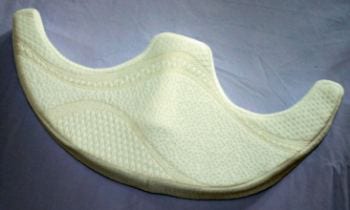
Comfort Quest’s Side Sleeper Pillow helps patients rest more comfortably after breast surgery.
The definitive cause of postmastectomy pain syndrome (PMPS) still remains unclear, but we do know that multiple factors are involved. The commonly cited theory proposes it occurs more frequently when the intercostobrachial sensory nerves have been cut during a lymphadenectomy.
These sensory nerves provide sensations predominantly to the shoulder and upper arm areas. Due to their location, which usually runs through the packet of lymph nodes in the armpit and exits through the chest wall muscles, the surgeon in the process of removing the lymph nodes commonly cuts them.
Chronic nerve pain has been estimated to occur in 20% to 25% of breast cancer patients following lymph node removal, with or without mastectomy. At any given time, more than 200,000 women are bravely enduring symptoms of PMPS.
CHRONIC PAIN OR NUMBNESS CAN PERSIST FOR MANY MONTHS
After this type of surgery, it is not uncommon for patients to develop chronic painful symptoms described as burning, tingling, itching, or piercing pain, which can persist for many months. Varying reports describe it as occurring on a continual basis or in response to changes in physical activity or temperature. The least problematic symptom would be numbness in the affected area.
Numbness occurs when there is a disruption in the connections between the nerves. Eventually, the brain stops expecting sensory input from the affected area. It sounds like a relatively mild side effect to the surgery in comparison to the other possibilities mentioned above. However, its emotional effect should never be underestimated. It is extremely annoying not to be able to feel sensations that one is accustomed to feeling. The deficiency can cause extreme frustration and great emotional distress.
Surprisingly, some studies appear to show symptoms of chronic pain syndromes when these nerves are preserved during surgery. However, most studies have shown a distinct correlation between the extent of armpit lymph node dissection and the subsequent development of chronic nerve pain syndromes involving the upper arm.
CHEST WALL AND SURGICAL SCAR PAIN
Another area in the constellation of symptoms that can occur in PMPS involves chest wall and surgical scar pain. Rather than being the result of an armpit lymph node dissection, this pain is more likely to be the direct result of extensive surgical removal of breast tissue. When large amounts of breast tissue are removed in the normal course of a mastectomy, the chest wall’s sensory nerves that permeate the skin are often cut or damaged, which disrupt the normal breast skin sensations.
In most patients, recovery from mastectomy involves marked numbness in the surgical areas, although some patients will experience unpleasant or painful tingling, pricking, or burning sensations on the skin (paresthesias).
NERVE REGROWTH
Regeneration of the disrupted nerves may occur in some patients over the course of many months or years. There is no guarantee of a pain-free or numb-free recovery, but the hope is they will regain at least some sensation in areas previously rendered numb by surgery. Sometimes, atypical connections between regenerating nerves and the uninjured nerves in the adjacent surgical areas may result in chronic paresthesias, hypersensitivity, and pain.
NEUROLOGICAL AND PSYCHO-EMOTIONAL RISK FACTORS

Deborah Cutter, PsyD, the inventor of the Side Sleeper Pillow.
A chronic pain syndrome can occur following a physical injury that causes damage to sensory nerves. It is noteworthy to state, not all patients who have undergone identical surgical procedures develop chronic pain syndromes. (In fact, most do not.) As with most chronic pain syndromes, there appears to be powerful neurological components and psycho-emotional factors that play a role in the development of PMPS. Healing rates are affected by these factors and are multifactorial in nature. More specifically, they are determined by each woman’s individual physical, emotional, and spiritual issues.
Your risk of developing PMPS increases with the length of time you experience and deal with pain. When you experience debilitating pain over a long period of time, one part of the brain—the limbic system—can become hypersensitized to painful stimuli. This can result in a sort of a feedback loop between injured sensory nerves and the emotional pain centers of the brain, which results in interpreting pain signals as much worse than they really are.
According to Robert Wascher, MD, FACS, a surgical oncologist in Orange County, Calif, the cause of such syndromes involves multiple factors and “involves both a physical injury to the patient’s nervous system and the subsequent development of loop-feedback circuits in regions of the central nervous system that convey and process painful stimuli, and assign emotional associations to such stimuli.”1
It is quite common for patients with chronic pain syndromes to experience depression at one time or another due to feelings of helplessness and/or hopelessness when the frustration of having to manage the pain day-in and day-out peaks. In these cases, cognitive behavioral counseling involving learning and practicing relaxation techniques and utilizing better coping mechanisms can be helpful in decreasing and managing the severity of the pain. Moreover, the parallel overlay of stress, anxiety, and fear that commonly accompanies a diagnosis of cancer further adds to the functional challenges women afflicted with PMPS experience.
Several recent studies suggest significantly reduced incidence of chronic pain syndrome in patients with breast cancer when minimally invasive surgical approaches were used in the management of surgeries involving primary tumors and axillary lymph nodes. It was also determined that using adequate analgesics during and after surgery can also reduce the incidence of PMPS.
If the surgeon is unable to help the patient find relief from the chronic pain, they will refer the patient to one or more medical professionals, including a professional pain management expert, a rehabilitation physician, a physical therapist, an occupational therapist, and/or a psychotherapist.
POSTSURGICAL RECOVERY PILLOW HELPS REDUCE RISK FACTORS AND SPEEDS RECOVERY
The Side Sleeper Post Mastectomy Recovery Pillow from Comfort Quest, Agoura Hills, Calif, is a new, innovative product for postsurgical comfort and recovery. The testimonials (www.mycomfortquest.com/Testimonials) from women who have used the Side Sleeper Pillow include heartwarming stories of how it improved the quality of their lives and helped them on the road to recovery. The value the pillow will bring to your life is the comfort it provides. We can never underestimate the importance of a good night’s sleep during the critical time of recovery. When the recovering patient is unable to rest comfortably for any extended period of time, it naturally will begin to affect her health.
Lifelong side and stomach sleepers are grateful that there is a product that can help get them off their backs. The quality of sleep directly affects the quality of health and the time it will take to fully recover. The comfort provided by the Side Sleeper Pillow helps kick-start a speedy recovery, aids healing, reduces pain, reduces dependence on medication, and helps the patient feel like herself again.
WASHER’S APPROACH TO PAIN SYNDROMES
Wascher’s approach to patients with chronic postoperative pain syndromes following breast cancer surgery begins even before he makes an incision. He is careful to explain the possible array of postoperative sensations, symptoms, and complications the patient might experience following surgery. In his experience, patients who have a realistic expectation of potential surgical outcomes are far better able to cope with complications of surgery than patients who are unsuspecting when problems develop. The early postoperative period, which he defines as 4 to 6 weeks after surgery, is a time when his patient is likely to experience a variety of physical and emotional sensations, most of them unpleasant. In most cases, such unpleasant sensations will gradually subside with the passage of time.
He believes that providing the patient with empathetic support, and the liberal prescribing of pain medication, go a long way toward aiding the patient’s recovery during this phase of their treatment. Based upon his knowledge of the known mechanisms of pain consolidation and reinforcement that occur in the central nervous system, he attempts to maximize preemptive pain-relief approaches.
Prior to making an incision, he uses a generous amount of local anesthetic even in patients undergoing surgery under a general anesthetic. Although data on preemptive anesthesia is very contradictory, with many studies showing no effect on long-term postoperative pain levels, he believes it certainly improves early postoperative patient comfort and reduces the amount of narcotics necessary to provide excellent analgesia. He does not skimp on the pain medications after surgery. However, he is always alert to the significant potential side effects inherent in the use of narcotic pain medications.
Wascher’s article1 goes into great detail of how patients who develop chronic pain in their scar, breast, chest wall, shoulder, or arm can be helped in several ways. Anti-inflammatory agents (eg, Ibuprofen and Naproxen) and low doses of antidepressant medications (eg, Elavil, Pamelor, and the SSRI-class of drugs, including Zoloft) can often be very helpful, although these agents must be taken consistently for several weeks to attain the greatest benefit. Unfortunately, narcotics are relatively ineffective against established chronic neuropathic pain, and the risk of narcotic dependency is very high when used for this purpose.
Topical counterirritants, such as capsaicin and mentholated creams, are useful in some cases, although their overall efficacy has been rather poor in most studies. Scar neuromas and localized scar pain can be treated by injection of local anesthetics and corticosteroids into the painful site. Frequently, serial injections over the course of weeks to months will dramatically improve the patient’s symptoms, sometimes on a very long-term basis.
In those patients who experience only temporary but complete relief following such injections, Wascher offers to excise the painful area of the scar along with the offending neuroma. In many cases, this provides excellent and permanent relief to the patient. In those patients who receive no appreciable relief of their pain following local scar injections, surgical removal of all or part of the scar is unlikely to be effective. Severe cases may involve intermittent or continuous injections of anesthetic and/or corticosteroids into the space around the spinal cord, which can have significant risks.
Recently, implantable spinal cord nerve stimulators have been evaluated for use in various chronic pain syndromes, and may hold promise. Other adjunctive modalities that are often beneficial include guided imagery training and biofeedback. Also, Wascher recommends consultation with a psychologist or psychiatrist who has expertise in treating patients with chronic pain syndromes. According to Wascher, “For many patients, even a partial reduction in the severity of their neuropathic pain symptoms with medications, when combined with behavioral therapy, can make an enormous difference on their overall level of comfort and function.”
ADJUNCTIVE TREATMENT INTERVENTIONS
In addition to treating chronic pain with medication, several studies have shown the importance of other modalities or holistic treatments to improve the physical and psychological health of women diagnosed with PMPS. According to Selim et al2:
- “Acupuncture was shown to significantly increase the range of arm motion, and reduce pain following axillary dissection.”
- Biofeedback and Guided imagery training was found to be helpful in reducing pain.
- Physical therapy was recommended for patients to prevent “frozen shoulder” syndrome, which can occur due to inadequate movement.
- “Psychological counseling was also shown as effective: improvements in both comfort and function were seen when patients underwent behavior therapy in addition to their medication. By consulting with psychologists/psychiatrists trained in chronic pain syndromes, these patients were able to address the psycho-emotional component in the limbic pain reinforcement pathways.”
PREVENTION IS THE IDEAL TREATMENT APPROACH
Chronic pain syndromes are complex conditions that are often difficult to treat. Currently, between 200,000 and 400,000 women are dealing with severe and painful postsurgical symptoms. According to Wascher, prevention is the ideal approach to this epidemic of a problem.
Comfort Quest’s Side Sleeper Post Mastectomy Recovery Pillow is an innovative product that embodies this ideal by preventing insomnia, exhaustion, frustration, and pain. In doing so, it improves recovery time, sleep quality, mobility, and independence, brings comfort, provides overall feelings of well-being, and helps you have the best possible recovery so you can feel like yourself again. It can be purchased at www.mycomfortquest.com as well as directly from your local certified mastectomy fitter’s boutique, where you can save on shipping and handling charges.
Deborah Cutter, PsyD, is a licensed clinical psychologist and executive director of Creative Behavioral Consultants Inc in Oak Park, Calif. She invented the Side Sleeper Pillow, a contour memory foam pillow designed for women recovering from breast cancer. She can be reached at (818) 932-9644, ext 205, or via e-mail at .
REFERENCES
- Wascher R. Post-mastectomy pain syndromes: A surgeon’s perspective. Available at: www.cancersupportivecare.com/surgerypain.html. Accessed January 9, 2012.
- Selim S, Shapiro R, Hwang E, and Rosenbaum E. Post breast therapy pain syndrome (PBTPS). Available at: www.cancersupportivecare.com/neuropathicpain.php. Accessed January 9, 2012.




